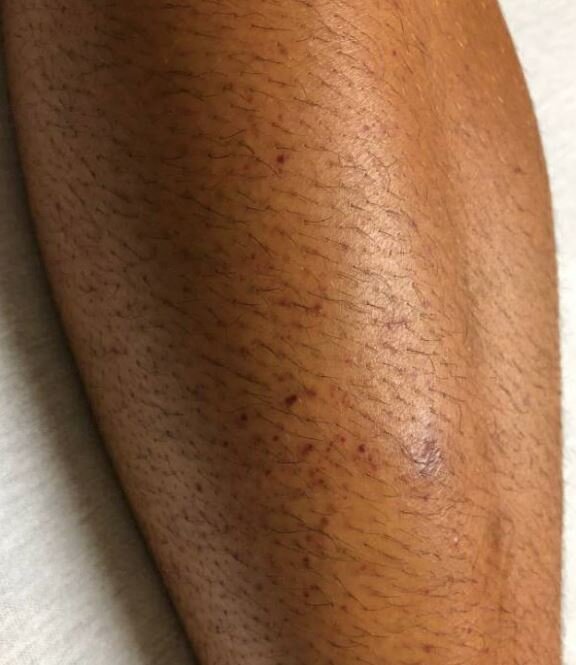A 27 y.o. male presented 8/21 with petechiae after being seen for pharyngitis which was strep/HIV/p24 Ag/covid negative.
His platelet count was 2,000 and he did not respond to platelet transfusion. He was discharged on tavalisse but returns with severe chest pain. What could be wrong?
the patient noted petechiae on multiple places on his body and complained his gums were bleeding when he brushed his teeth.
Our patient developed pulmonary emboli even though his platelet count was low. Splenectomized and elderly patients tend to be at risk for clotting even with low platelets.
Immune thrombocytopenia- is a group of heterogeneous disorders that cause platelet autoantibodies. A platelet count of < 100,000 is necessary to make the diagnosis. 80% respond to IVIG, splenectomy or rituximab. In refractory cases a thrombopoietin receptor agonist , eltrombopag or romiplostim can be given.
Thrombocytopenia is a recognized complication after Epstein-Barr virus infection, varicella, cmv, rubella, HIV, and hepatitis A, B or C. In children recovery usually occurs without treatment. In adults, however, the disease may become chronic. Recently, ITP has been reported after COVID infection.
ITP has been reported with lupus, hiv and many other conditions.
ITP is characterized by the duration of the thrombocytopenia. Acute ITP lasts fewer than 3 months, , persistent lasts 3-12 months, and chronic lasts longer than 12 months. Treatment is instituted when the platelet count in <30,000 or significant bleeding occurs. Our patient has had low platelets for three months and developed hemolytic anemia with haptoglobin < 10. He continues on Tavalisse. B cell malignancies are associated with ITP and autoimmune hemolytic anemia and he is being followed for the possible development of lymphoma
Patient presenting with ITP after a COVID infection
Rand M, Wright J. Virus-associated idiopathic thrombocytopenic purpura. Transfus Sci. 1998 Sept 19(3): 253-9.
Ruggeri M, Tosetto A, Palandri F,et al. Thrombotic risk in patients with primary immune thrombocytopenia is only mildly increased and explained by person and treatment related risk factors. J Thromb Haemost. 2014;12:1266-1273.
Norgaard M, Cetin K, Maegbaek M, et al. risk of arterial thrombotic and venous thromboembolic events in patients with primary chronic immune thrombocytopenia: a Scandinavian population-based cohort study. Br J Haematol. 2016 Aug;174(4):639-42.
Cines D, Bussel J, Liebman H, Prak E. The ITP syndrome: pathogenic and clinical diversity. Blood, 2009 Jun 25;113(26):6511-6521.
Stepman G, Daley I, Braits D, et al. A Case of immune thrombocytopenia after COVID-19infection. Cureus June 22,21. Doi:10.7759/cureus 15843.
Rogers K, Boxer M, Choi M, et al. Fostamatinib, a spleen tyrosine kinase inhibitor for the treatment of wasrm antibody autoimmune hemolytic anemia : final results of the Phas 2, multicenter , open-label study. Blood, vol 134 Issue supplement Nov 13, 2019.



